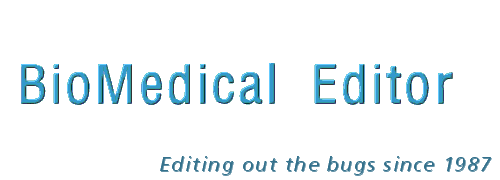Science Editing and Proofreading Tasks
The tasks associated with each science editing service are listed below. If you are not sure which editing
services are right for your project, please
contact me online.
ADVANCED SCIENCE EDITING
(Stylistic/Substantive Editing)
Improves language style and flow; clarifies meaning; eliminates wordiness; checks organization, logic, and
coherence; may involve condensing or reorganizing. Includes Standard Editing and Journal Formatting.
Who may benefit from Advanced Science Editing?
- Authors who want to ensure clear wording, smooth language, and well-flowing ideas
- Authors whose first language is not English
- Authors who want to eliminate wordiness, jargon, and awkward phrasing
- Authors who require an overall check for structure, logic, and organization
What tasks are included in Advanced Editing?
- Completing the tasks for Standard Editing (see below)
- Improving clarity and precision
- Eliminating repetition, wordiness, and awkward phrasing
- Eliminating biased language and inappropriate jargon
- Smoothing language and improving flow in sentences and paragraphs
- Conforming to natural English expression
- Reducing passive construction as appropriate
- Ensuring clarity and parallelism in text, tables, and headings
- Ensuring that titles, headings, tables, and illustrations reflect text content
- Reorganizing and condensing sentences and paragraphs, as required
- Querying gaps or contradictions in information presented
- Confirming that all stated aims and issues raised are completed
- Confirming that the argument is presented logically
STANDARD SCIENCE EDITING (Copy Editing)
Corrects errors in spelling, grammar, punctuation, and usage; ensures internal consistency of facts; maintains
consistent overall style.
Journal Formatting may be added on request.
Who may benefit from Standard Science Editing?
- Authors who need no help with the language or organization of their well-written document
- Authors who have had their document edited previously for content, structure, and style
- Authors who want to eliminate remaining mechanical errors and achieve overall consistency
What tasks are included in Standard Editing?
- Correcting faulty spelling, grammar, and punctuation
- Correcting word usage (e.g., affect/effect)
- Ensuring consistent style of citations and references
- Ensuring consistent cross-referencing of tables, figures, and references
- Ensuring consistent style of capitals, abbreviations, numbers, and lists
- Ensuring internal consistency of facts, data, and scientific units
- Maintaining a consistent overall style (e.g., AMA, APA, CSE, house style)
JOURNAL FORMATTING
Adapts a manuscript to suit the style guidelines of a specific scientific journal or publisher.
Who may benefit from Journal Formatting?
- Authors who need their manuscript to comply with a journal's instructions for authors
What tasks are included in Journal Formatting?
- Adapting text to suit style, spelling, and punctuation requirements
- Reformatting references and citations to suit journal style
- Reorganizing main sections of manuscript to suit journal guidelines
- Rearranging tables, figures, and figure legends to suit guidelines
- Condensing abstract or main text (reducing number of words to fit within limit)
- Ensuring manuscript adheres to special instructions (e.g., acronyms, units, and symbols)
PROOFREADING
Compares the current document with a previous one or corrects final errors in the proofs of a previously
edited document.
Who may benefit from proofreading?
- Authors whose previously edited document needs a final check to catch remaining errors
What tasks are included in Proofreading?
- Using standard proofreaders' marks to identify indisputable errors
- Catching grammar, spelling, punctuation, and formatting errors
- Checking headers, footers, page breaks, and word breaks
- Checking other elements of design and layout
How is editing done? I correct text electronically in the MS Word file with Track Changes turned on.
I add notes electronically, either by using the Comment feature or by inserting them directly in text, as you prefer.
How is proofreading done? I correct text by using Adobe Acrobat and marking annotations electronically.
Alternatively, I can proofread on paper. See Sample Proofreading Marks
for more information.
